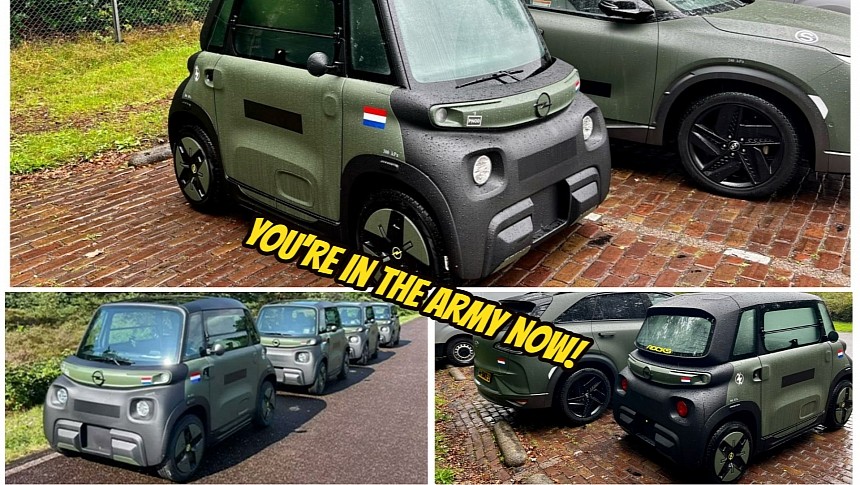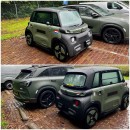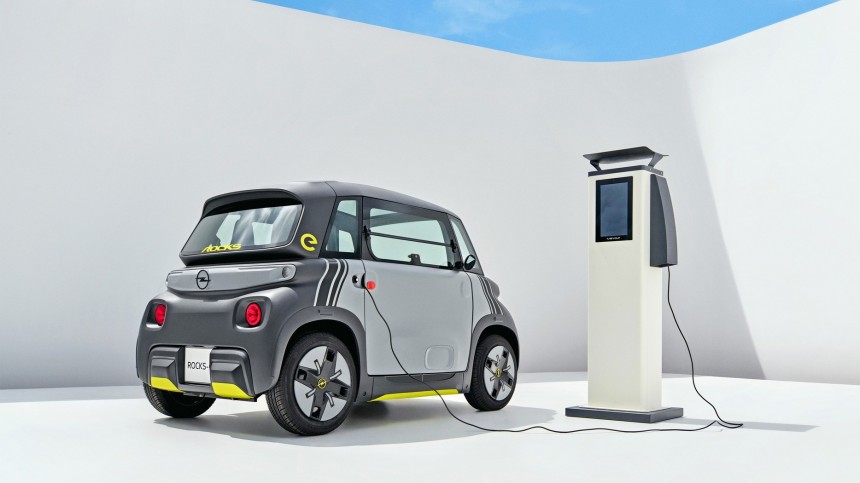The Opel Rocks-E is one of those electric vehicles (EVs) that would not do well sales-wise in the US or Canada. But for the Royal Netherlands Army (Koninklijke Landmacht), it might just be what they needed. The five units they bought are going to different branches. Here's the gist of it.
As a former General Motors brand that's now part of the Stellantis group, Opel is in a rather peculiar stage. It must reposition itself as one of Germany's (and other European countries) top options for budget-friendly vehicles that do not stray away from the reputation of German-built quality.
It can't be Dacia because it's expected more from it, but it also can't try to fight Audi. In theory, at least, it should find a way to convince prospective VW customers to make the switch.
But with so many options available within Stellantis, it's not hard to create something of your own. The most important parts are already there for the taking. And that's what Opel already did. It took advantage of the auto giant's platforms and created some of its own vehicles by inserting its DNA into on-brand redesigns.
The Rocks-E, for example, is based on the Citroen Ami. Fiat, another Stellantis brand, also released a version of the cute golf cart-like EV known as Topolino.
But the Rocks-E, the Ami, or the Topolino can't be cataloged as cars. The automakers were savvy when they approached making a small, cheap, and somewhat practical EV. These two-door units are quadricycles. That allows them to sidestep a plethora of regulations that could have meant more production costs and unwanted extra weight. It also makes them attractive to Europeans under 18 years old and want to drive to school or meet with friends.
In some countries, things look even better for teenagers - they do not need a driver's license to get behind the steering wheel of an e-quadricycle like the Rocks-E.
The two-seater unit has a top speed of 28 mph and weighs 1,308 lb thanks to a Li-ion battery of 5.5 kWh that enables it to travel around 46 miles on a full charge. It rides on 14-inch wheels and comes with the charging cable included. Recharging the energy storage unit takes approximately four hours. It can be plugged in at any standard household socket. As you may have guessed, there is no DC fast charging option. Adding it for such a small battery wouldn't have made sense.
An entry-level version of the front-wheel-drive Rocks-E costs €7,990 ($8,710), but if customers want more equipment, they must spend an extra €790 ($861) for the Klub or TeKno trims.
But cue Status Quo's "In the Army Now" because the Rocks-E just joined the Royal Netherlands Army!
According to a Rotterdam-based Sergeant Major working as a Diversity&Inclusion Recruiter, the five Opel Rocks-E will be used for local transportation needs in military bases. They could transport personnel from barrack to barrack or be used as a climate-friendly way to go from the sleeping area to the work post. At the same time, they could end up on patrol duty to secure militarized sites.
Three of these EVs will be used by the Air Force, one will go to the Den Helder Navy military base, and another will remain at Camp New Amsterdam, where the US has personnel deployed too.
But some updates will be performed to turn the cute little EV into a military vehicle. Sadly, we aren't offered the details regarding the modifications. Were we to guess what could be added, we would say that a set of extra lights, a radio, and maybe even some amber warning lights.
Opel also launched the Opel Rocks-e KARGO, which is aimed at restaurants or delivery companies that have to deal with reaching customers in crowded urban areas.
Finally, it looks like the Dutch are experimenting with changing the propulsion systems of the vehicles they use daily. The Sergeant Major that shared the information also got to drive a hydrogen-powered Hyundai Nexo for the second time in two years.
It can't be Dacia because it's expected more from it, but it also can't try to fight Audi. In theory, at least, it should find a way to convince prospective VW customers to make the switch.
But with so many options available within Stellantis, it's not hard to create something of your own. The most important parts are already there for the taking. And that's what Opel already did. It took advantage of the auto giant's platforms and created some of its own vehicles by inserting its DNA into on-brand redesigns.
The Rocks-E, for example, is based on the Citroen Ami. Fiat, another Stellantis brand, also released a version of the cute golf cart-like EV known as Topolino.
But the Rocks-E, the Ami, or the Topolino can't be cataloged as cars. The automakers were savvy when they approached making a small, cheap, and somewhat practical EV. These two-door units are quadricycles. That allows them to sidestep a plethora of regulations that could have meant more production costs and unwanted extra weight. It also makes them attractive to Europeans under 18 years old and want to drive to school or meet with friends.
In some countries, things look even better for teenagers - they do not need a driver's license to get behind the steering wheel of an e-quadricycle like the Rocks-E.
The two-seater unit has a top speed of 28 mph and weighs 1,308 lb thanks to a Li-ion battery of 5.5 kWh that enables it to travel around 46 miles on a full charge. It rides on 14-inch wheels and comes with the charging cable included. Recharging the energy storage unit takes approximately four hours. It can be plugged in at any standard household socket. As you may have guessed, there is no DC fast charging option. Adding it for such a small battery wouldn't have made sense.
But cue Status Quo's "In the Army Now" because the Rocks-E just joined the Royal Netherlands Army!
According to a Rotterdam-based Sergeant Major working as a Diversity&Inclusion Recruiter, the five Opel Rocks-E will be used for local transportation needs in military bases. They could transport personnel from barrack to barrack or be used as a climate-friendly way to go from the sleeping area to the work post. At the same time, they could end up on patrol duty to secure militarized sites.
Three of these EVs will be used by the Air Force, one will go to the Den Helder Navy military base, and another will remain at Camp New Amsterdam, where the US has personnel deployed too.
But some updates will be performed to turn the cute little EV into a military vehicle. Sadly, we aren't offered the details regarding the modifications. Were we to guess what could be added, we would say that a set of extra lights, a radio, and maybe even some amber warning lights.
Opel also launched the Opel Rocks-e KARGO, which is aimed at restaurants or delivery companies that have to deal with reaching customers in crowded urban areas.
Finally, it looks like the Dutch are experimenting with changing the propulsion systems of the vehicles they use daily. The Sergeant Major that shared the information also got to drive a hydrogen-powered Hyundai Nexo for the second time in two years.

















